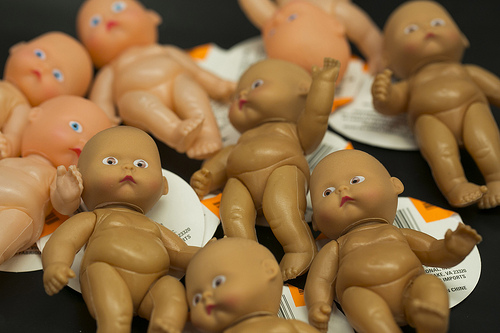
There are several chemicals that have become household terms thanks to a growing awareness of their harmful effects. Bisphenol-A (BPA) and phthalates are amongst the bad guys of the 80,000 chemicals approved by the EPA we know we should avoid…but phthalates are a bit tricky.
In 2008, the the Consumer Product Safety Improvement Act in 2008 banned certain types of phthalates from toys that enter children’s mouths: BBzP, DnBP and DEHP, as well as “tentatively banned three others — DnOP, DiDP and DiNP”. Naive as I am, I assumed all phthalates were one in the same and part of this ban.
The good news is exposure to the banned phthalates has gone down; however, exposure to their replacement phthalates has increased at alarming rates. What else would we expect? Remove one plastic softener from the market and companies will replace it with another.
Greenwire explains:
Despite the ban, manufacturers are still allowed to use several other types of phthalates in consumer products. Research published today in the journal Environmental Health Perspectives suggests companies are shifting to different forms of the compounds, used to soften plastic — even though studies say they can cause health and reproductive problems.
“We were excited to see that exposure to some of the phthalates that are of public health concern actually went down,” Ami Zota, an assistant professor of environmental and occupational health at George Washington University, who conducted the research while a fellow at the University of California, San Francisco, said in a statement. “Unfortunately, our data also suggest that these are being replaced by other phthalates with potential adverse health effects.”
The 2008 law banned three types of phthalates — BBzP, DnBP and DEHP. It also tentatively banned three others — DnOP, DiDP and DiNP — from toys that could enter a child’s mouth. While the phthalates subject to the permanent ban showed decreases in exposure, two of the versions not banned permanently saw slight increases. The third, DiNP, saw a 150 percent increase in exposure, which the researchers suggested could be because industry is using it to replace the most harmful phthalates. California health officials recently added DiNP to the state’s list of chemicals known to cause cancer, birth defects or reproductive harm.
When we look at banning chemicals, we need to also consider what they will be replaced with, as they will be replaced. We need to find safer alternatives that are truly safer.
Once again, I am reminded it is best to avoid plastic, especially in children’s toys. Although I am not a proponent of binkies, it is really scary to consider these chemicals are in most baby pacifiers.
Image: License![]()
![]() Some rights reserved by CBP Photography
Some rights reserved by CBP Photography
Leave a Reply